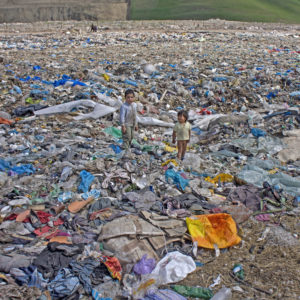“We are children of our landscape [which] dictates behavior and even thought,” writes Lawrence Durrell. It goes without saying, therefore, that a baneful “landscape”—defined in the broadest terms—has devastating effects on the inhabitants. At the Huntsville Museum of Art, the photographs of Karen Graffeo and sculptures by Jim Neel offer vivid, indeed fearsome images of children living in unspeakable “landscapes,” under extremes of deprivation and war. “Let Us Now Praise the Roma,” Graffeo’s compelling ongoing series since 1999, of images of Gypsy children in Romania, reveals the stalwart resilience of toddlers and teenagers existing in unspeakable poverty and deplorably unsanitary conditions. Neel focuses on the “landscape” of the Syrian civil war, whose young victims he dramatizes in toy-like sculptures in ceramic and mixed media.
Echoing the 1941 book by Walker Evans and James Agee, Let Us Now Praise Famous Men, which highlights the plight of white sharecroppers in the South during the Depression ’30s, Graffeo’s series includes intimate shots of the Roma, a displaced, marginalized people, now living all over the world, identified by both linguistic and genetic evidence to have migrated millennia ago from Northwestern India. For this show Graffeo photographed a group of 76 families relocated by the government to the Pata Rât landfill from a newly gentrified area in Cluj-Napoca. Not only are they paid only a pittance for the materials they scavenge from the garbage, but they are required to pay rent as well.

Karen Graffeo, In the Patarat Landfill, Romania, 2013 ©Karen Graffeo, courtesy of Huntsville Museum of Art, Huntsville, AL.
Graffeo’s images are at once poignant and inspiring. In Water (2014), a prepubescent girl squats in the mud, looking squarely at the viewer, eyes squinting in the sun, blonde hair disheveled. Her hand rests with determination on a crumpled plastic container to be filled with water from a hose partially embedded in the slime: the only water source for about 500 people. Equally arresting is the shot of two young boys, In the Pata Rât Landfill, Romania (2013) standing in a desolate “landscape” littered with party-colored detritus. The younger turns to gaze wistfully at his sibling, seemingly unconcerned that he wears nothing below his soiled top. Particularly gripping is the group photo of five children huddled together, Ponorâta, Romania (2013), each wearing a sad, searching expression. Held firmly on his sister’s lap, the baby in the center holds his legs apart, revealing his genitals, like the Christ Child in Renaissance paintings.
These oppressed people offer a thought-provoking echo of the culture which has largely rejected them. Brightly colored cloth and plastics found among the discards brighten their simple shanties, and they wear cheap jewelry and T-shirts found in the garbage.
But most impressive is the fact that when photographed, they sometimes try to imitate the poses of fashion magazines and, sadly, even pornographic publications—the latter decidedly vetoed by the artist. Melinda, 15 Years Old (2013) provides one such reflection of contemporary mores as she looks directly at the camera, her hand to her cheek in an affected gesture. Having had three miscarriages, the teenager asked Graffeo for birth control pills.
Making art, for over 30 years, designed to expose the particularly horrific effects of war on the young, Neel recently spent time in Antakya, Turkey, where he witnessed refugee children injured and maimed in Aleppo, just over the Syrian border. The series on display derives largely from dolls and baby shoes—his own—found among his mother’s things after she died. Using the dolls as metaphors of children, he cast them in porcelain during a residency at the Kohler Company in Wisconsin.

Jim Neel, Target No. 1, 2016 ©Jim Neel, photo by Oliva Reed, courtesy of Huntsville Museum of Art, Huntsville, AL.
Titled Scars (2016), an enlarged baby doll, face and chest disfigured by prominent keloids, is propped against a steel oil drum. Not only does the drum serve as a reminder that oil is an underlying motive in the Syrian war, but also of Asra-a, the 8-year-old he met, who had been severely burned by shrapnel from a barrel bomb that ignited a fuel tank on her roof. Another doll is perforated by bullet holes, Target No. 2 (2016), and yet another riddled by protruding bullets, Target No. 1 (2016). Sitting in a baby’s rocker, the doll titled Mended (2016) seems oblivious to the fact that its right arm has been replaced by a wooden one, a benign, unknowing expression underscoring its role as victim. A heap of baby shoes titled Cost (2016) remembers not only the children killed in Syria but also those exterminated in the Nazi death camps, their discarded shoes on display in Holocaust museums around the world.
“An axe for the frozen sea within us,” to borrow from Franz Kafka, the photographs and sculptures of Connections serve as trenchant reminders of young lives deformed or taken away altogether by indifference, greed and war.


